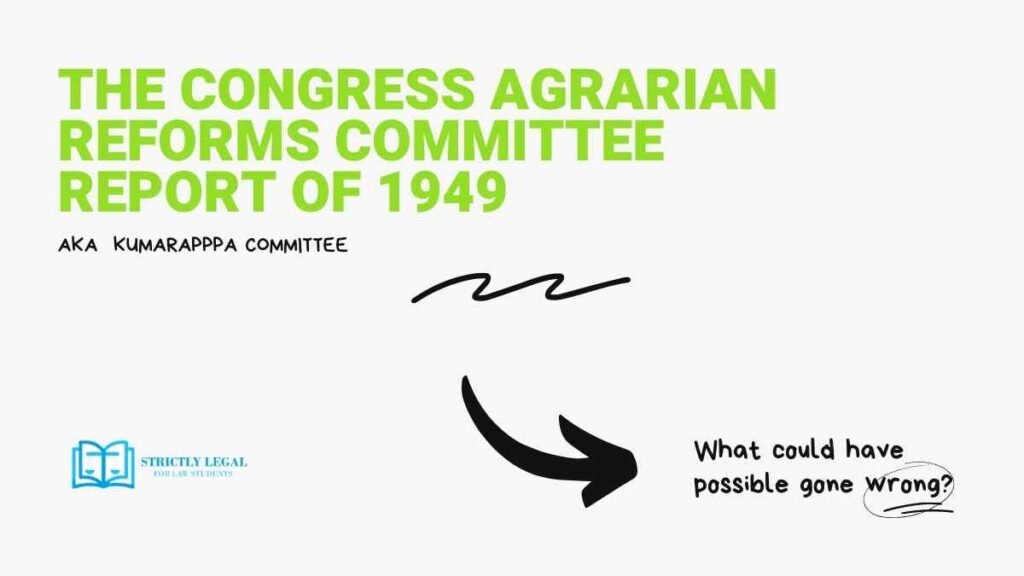Before we come to criticize the much already criticized Agrarian Reforms Committee of 1949, it is important we understand the reason why this committee came intro being and the backdrop that compelled the Congress to have this dialogue.
Table of Contents
Why was the Congress Agrarian Reforms Committee Set up?
The Britishers left India in 1947 leaving behind a “permanent land revenue system” which is also popularly known as the Zamindari System. In simpler terms if we have to understand this system, those who were able to pay a fixed sum of money to the British as land tax were made owners of the demarcated land. These owners, then better known as zamindars would further lease, sub-lease and rent out these lands in exchange for exorbitant revenues. This parasitic class of intermediaries exploited the actual tillers of the land and created a worse degrading socio-economic culture in the state.
The Zamindars made huge profits from this and therefore they were the staunch supporters of the British at that time. For a political party that was mobilizing the Indian Masses against the British rule, this was not a very good thing. After Independence, in one of its Annual General Meeting, the Indian National Congress declared that it would support abolition of zamindars.
The congress agrarian reforms committee I set up by Dr. Rajendra Prasad in December, 1947 and chaired by J.C. Kumarappa sought to recommend and report on the abolition of Zamindari System, Co-operative farming methods of improving, agricultural productions, position of small holdings and a wide range of reforms.
After a brief legal battle, the congress party amended the Constitution and abolished the Zamindari System. Since, this policy helped the farming community and the land tillers in general everybody accepted it without much hue and cry.
“To leave out the problem of agricultural labor in any scheme of agrarian reform- as it has been done so far is to leave unattended a weeping wound in the agrarian system of the country”
Congress Agrarian Reforms Committee in 1949
This blog post in particular will discuss the reforms as was suggested then in 1949 and the criticism surrounding it.
What were and recommendations and why was it criticized?
The recommendations were such as:

(1) The agrarian economy policy should provide an opportunity for the development of the farmer’s personality;
(2) There should be no scope for exploitation of one class by another;
(3) There should be maximum efficiency of production; and
(4) The scheme of reforms should be within the realms of practicability.
These recommendations probably would yield to better things if it weren’t so vague. For example, the committee recommended adoption of policies for development of the farmer’s personality. But what sort of personality and the details weren’t discussed. It appeared that these recommendations were mere opinions instead of guides for some actionable plans or reforms.
Land Holdings
In another Instance, the committee when discussing about ‘Economic Land Holdings’ states in the report that it should be decided on the basis of prevailing economic conditions. It lays down certain principles like the holdings must be such that it is able to accord a reasonable standard of living to the cultivator. And it should at least be able to employ a family of a normal size and a pair of bullocks. But the committee failed to define terms like ‘Reasonable standard of living’, ‘ Family of normal size’ thereby bringing in too much vagueness in the report.
Tenancy Reforms
The Congress Agrarian Reforms Committee or the Kumarapppa Committee recommended against any system of cultivation by
tenants. And mentioned that leasing of land should be prohibited except in the case of minor, widow or disabled persons. It is said that the committee could have recommended a maximum tenure for leasing (1 year or so) instead of a blanket ban.
Co-operative Farming
On the topic of co-operative farming, the committee suggested that a ‘basic holding’ rule should be introduced and any land holding below the basic size should be merged with other similar holdings to bring in a sort of co-operative farming arrangement. The only thing that the committee failed to understand, probably is that in co-operative farming there’s necessarily an element of democracy. Each unit co-operates with the other. Suggesting such forced measures of co-operative farming or intervention of the Slate the end result is bound to be ugly.
Debt Control
When it comes to the farmer’s debt, the committee has suggested scaling down their loan taking capacity on the basis of their ability to repay. On the other hand the debts of the agricultural laborers are to be completely dissolved or wiped out. It suggests measures to register and control money lender but surprisingly it fails to suggest a fair rate of interest at which the money lending business should prevail.
While suggesting that the credit unworthy cultivators should be subsidized, it failed to mention who is to subsidize them, the center or the respective states? Should it come through an existing channel or a new arrangement should be set up?
Agricultural Laborer
To improve the social and economic positions of the agricultural labourers the committee recommended three things majorly:
- Banning of serfdom, a condition which a tenant farmer is bound to a hereditary plot of land and to the will of his landlord.
- Implementation of Minimum Wage Act.
- Provision for housing.
On the problem of unemployment and under employment the committee recommended setting up of employment bureau.
Conclusion
These are just a few criticisms that I could cover in this particular blog. Please be aware that the Congress Agrarian Reforms Committee or the Kumarapppa Committee’s recommendations helped the government form policies and bring large reforms in the agrarian system of the country. Despite large efforts made in the direction of agrarian reforms, the agricultural Industry still remains underdeveloped and highly unsatisfactory. It is in that context that we should study these recommendations and understand where we went wrong.

Passionate about using the law to make a difference in people’s lives. An Advocate by profession.





